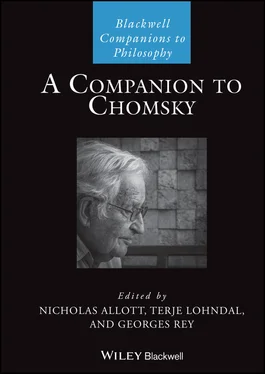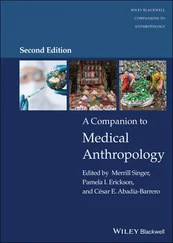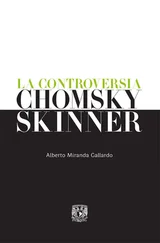A Companion to Chomsky
Здесь есть возможность читать онлайн «A Companion to Chomsky» — ознакомительный отрывок электронной книги совершенно бесплатно, а после прочтения отрывка купить полную версию. В некоторых случаях можно слушать аудио, скачать через торрент в формате fb2 и присутствует краткое содержание. Жанр: unrecognised, на английском языке. Описание произведения, (предисловие) а так же отзывы посетителей доступны на портале библиотеки ЛибКат.
- Название:A Companion to Chomsky
- Автор:
- Жанр:
- Год:неизвестен
- ISBN:нет данных
- Рейтинг книги:3 / 5. Голосов: 1
-
Избранное:Добавить в избранное
- Отзывы:
-
Ваша оценка:
- 60
- 1
- 2
- 3
- 4
- 5
A Companion to Chomsky: краткое содержание, описание и аннотация
Предлагаем к чтению аннотацию, описание, краткое содержание или предисловие (зависит от того, что написал сам автор книги «A Companion to Chomsky»). Если вы не нашли необходимую информацию о книге — напишите в комментариях, мы постараемся отыскать её.
Companion
Companion
A Companion to Chomsky
A Companion to Chomsky — читать онлайн ознакомительный отрывок
Ниже представлен текст книги, разбитый по страницам. Система сохранения места последней прочитанной страницы, позволяет с удобством читать онлайн бесплатно книгу «A Companion to Chomsky», без необходимости каждый раз заново искать на чём Вы остановились. Поставьте закладку, и сможете в любой момент перейти на страницу, на которой закончили чтение.
Интервал:
Закладка:
As we noted at the beginning of this introduction,another approach that is often assumed to be incompatible with Chomsky's approach is statistical learning in its many different guises. In Chapter 17, Lisa Pearl argues that this is too simplistic, and that statistical learning can both complement UG and help refine our models of its contents. Her focus is in particular on how statistical modeling provides a better understanding of how learners navigate the hypothesis space they are faced with, and she argues that within an approach that remains generative, statistical learning might even replace UG as an explanation for at least certain properties of the adult grammar and how they are acquired.
The last chapter in this section, Chapter 18, written by Frederick Newmeyer, scrutinizes differences between Chomsky's linguistics and what can broadly be labeled “usage‐based linguistics.” The latter is an umbrella term for a variety of approaches that share the commitment to study the use of language as opposed to focusing on the underlying computational systems of syntax that enable such use. This includes “constructionist” work that sees the basic units of language as grammatical constructions (e.g. active and passive) and the “functionalist” perspective that regards the use of language (primarily in communication) as a major influence on grammar. Comparing Chomsky's work to the shared commitments of usage‐based linguistics is complicated by the fact that Chomsky has rarely engaged with published work in this tradition. However, Newmeyer solves this problem by selecting what he takes to be the most important issues separating the two traditions and carefully outlining the positions that they have taken on those issues.
1.5 Part IV: Processing and Acquisition
There is no doubt that Chomsky was a core member of the group that started what is often called “the cognitive revolution” (Miller 2003), which he spearheaded with his critique of B.F. Skinner (Chomsky 1959). His work ensured that linguistic competence was viewed as part of cognition and, together with developments in psychology and philosophy, that mental computations over representations came to be seen as a legitimate and fertile area of research. In this section, we consider his legacy in two areas that we have labeled processing and acquisition .
Chapter 19by Dave Kush and Brian Dillon explores how Chomsky's work has influenced research on one area of linguistic performance, namely sentence processing or “parsing.” In particular, they carefully demonstrate with examples how grammatical theory is relevant to such research: specifically, how the theory makes predictions about the behavior of the parser.
Work on parsing and linguistic perception focusses on real time processing of language, connecting syntax with psycholinguistics. A more recent development is research into the neurolinguistic underpinnings of language, which is the topic of Emiliano Zaccarella and Patrick C. Trettenbrein's Chapter 25. In particular, they are concerned with the neural signatures of the core components of grammar as put forward in much of Chomsky's work: universal principles of grammar, constituency, recursion, and Merge. The identification of such signatures supports Chomsky's claim that language is a biological system and that his work has significant implications for the study of the neuroscience of language.
Ever since Chomsky (1959), but in particular with Chomsky (1965), language acquisition has been a vital concern when developing theories that can model humans' linguistic abilities. This, in part, arises from Chomsky's conception of language as being essentially a biological phenomenon, where facts about growth and development are often essential to the characterization of its structure: a full theory of the structure of the eye needs to include an account of how it grows. Thus, for Chomsky, a central goal of linguistic theory has been what he calls “explanatory adequacy,” i.e., it must at least account for the possibility of language acquisition. And here a core argument has always been that children are born with the relevant constraints that determine the “hypothesis space” for acquiring the grammatical rules in a given language, what has traditionally been referred to as UG. In Chapter 21, Stephen Crain and Rosalind Thornton provide many examples of children's acquisition of restrictions on co‐reference that demonstrate the necessity of UG for any explanatory account of child language development.
Another area where Chomsky's ideas about innateness have been important is the linguistics of the spontaneous sign languages of the deaf. In Chapter, Diane Lillo‐Martin provides an overview of research on sign language grammar that has been inspired by Chomsky, focusing particularly on what that grammar can tell us about the innateness of linguistic abilities and cognitive modularity more generally.
The last area that this section surveys is work done on atypical acquisition. This encompasses two different types of cases: instances where there is no essential input during the early stages of acquisition, and instances where the stimulus is rich but insufficient due to some disorder. In Chapter
23by Neil Smith and Ianthi Tsimpli, these cases are discussed in detail from the point of view of the influence of Chomsky's work. Smith and Tsimpli show that they provide invaluable evidence about the language faculty and its distinctness from and interaction with other aspects of human cognition.1.6 Part V: Semantics, Pragmatics, and Philosophy of Language
Chomsky's work on grammar sees language as a bridge between sound and meaning, and has always aimed to explain certain facts about linguistic meaning. “Meaning,” of course, is a controversial and polysemous term, and the different entries in this section address some of the very different concerns to which it is attached.
One issue that has always been central to generative grammar is why certain readings of sentences are and others are not possible for certain sentences. For example, why can The man called the woman from Montana mean “The man called the woman, who was from Montana,” and “The man called, from Montana, the woman,” but not “The man, who was from Montana, called the woman”? And why are superficially very similar sentences understood so differently ( John is easy to please entails It is easy to please John , but John is eager to please does not entail * It is eager to please John )? Equally, why do certain distinct strings have related or identical meanings (as with an active sentence and the related passive, for example)? Chomsky and other generativists provide answers in terms of underlying hierarchical sentence structures and constraints which explain both which structures can be generated and transformed, and how their constituents relate to each other: that is, by providing a syntactic theory. It is in this respect that generative syntax can be said to be essentially concerned with meaning.
Chomsky has, however, always opposed the widely held functionalist view of language according to which the purpose of language is communication, and the associated methodology that seeks to explain syntactic facts –which kinds of configurations of linguistic items are possible– in terms of semantic function, i.e., what they are used for. (Such views are discussed in Newmeyer's chapter in section 3.) Chomsky's view is that if language has any purpose at all, it is the expression of thought. He notes that many, indeed the vast majority of grammatical sentences, are hardly usable, because they are too long – e.g. example (2), or hard to parse (3), or combine words that are syntactically but not semantically compatible (4), for example:
Читать дальшеИнтервал:
Закладка:
Похожие книги на «A Companion to Chomsky»
Представляем Вашему вниманию похожие книги на «A Companion to Chomsky» списком для выбора. Мы отобрали схожую по названию и смыслу литературу в надежде предоставить читателям больше вариантов отыскать новые, интересные, ещё непрочитанные произведения.
Обсуждение, отзывы о книге «A Companion to Chomsky» и просто собственные мнения читателей. Оставьте ваши комментарии, напишите, что Вы думаете о произведении, его смысле или главных героях. Укажите что конкретно понравилось, а что нет, и почему Вы так считаете.












